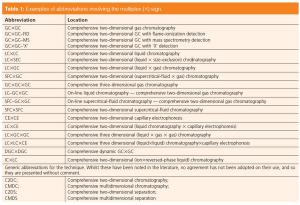Articles by Philip J. Marriott

We might well ask “Where is gas chromatography (GC) heading?” For many analysts, the answer may be just “more of the same,” reflecting that GC is mature and that most analysis tasks and sample types have been tried and tested. In this scenario, any changes to the basic method may be marginal—sample introduction, and maybe a new detector? But beneath this status quo is an undercurrent of passion, excitement, and power.

Pressure tuning makes it easy to change the orthogonality in the 2D space.

Comprehensive two-dimensional gas chromatography (GC×GC) offers significant improvement for volatile chemical separation. Selecting suitable first (1D) and second dimension (2D) columns normally requires consideration of the chemical composition of a sample. Replacing one of these dimensions with a two-column ensemble (for example, 1D1 + 1D2 for the 1D column), provided with a pressure tuning makeup gas between them, varies the relative retentions of compounds before the modulation step according to the junction pressure. This makes it possible to alter the apparent polarity of the 1D ensemble, and this alters peak positions in the 2D GC×GC space. This article presents an account of studies that suggest this offers potential for improved operation for a GC×GC laboratory.
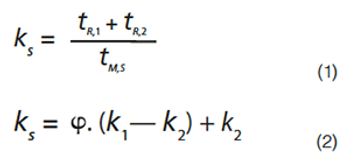
Comprehensive two-dimensional gas chromatography (GC×GC) offers significant improvement for volatile chemical separation. Selecting suitable first (1D) and second dimension (2D) columns normally requires consideration of the chemical composition of a sample. Replacing one of these dimensions with a two-column ensemble (for example, 1D1 + 1D2 for the 1D column), provided with a pressure tuning makeup gas between them, varies the relative retentions of compounds before the modulation step according to the junction pressure. This makes it possible to alter the apparent polarity of the 1D ensemble, and this alters peak positions in the 2D GC×GC space. This article presents an account of studies that suggest this offers potential for improved operation for a GC×GC laboratory.


Ionic liquids (ILs) have become recognized in gas chromatography (GC) as stable and highly polar stationary phases with a wide application range. Having customizable molecular structures, ILs also offer a particular tunability that provides additional selectivity, and therefore may improve separation for neighbouring analytes. This article presents specific properties of IL phase capillary GC columns, including polarity scale and inner surface morphologies of IL columns. Application of IL phases in
achiral and chiral GC, and multidimensional GC, are highlighted.

A review of nomenclature and conventions used in comprehensive multidimensional chromatography. An update of the popular paper on this topic from 2003.
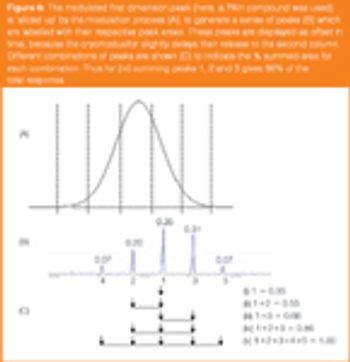
The interpretation of comprehensive two-dimensional gas chromatography (GCÃ-GC) based on the modulation ratio (MR) concept encompasses method implementation, ideas on quantitative measurement and how modulation phase affects GCÃ-GC.

It may be somewhat audacious to claim that some methods in GCÃ-GC can be called non-classical - the technique has only been around for about 15 years and one might argue that this is not long enough to establish a suite of classical methods.

In June of this year, the 30th meeting in the International Symposium in Capillary Chromatography series will convene in Dalian, People's Republic of China. The meeting promises to be a major celebration of separation science, and the separation science community has thrown its weight behind this initiative. The meeting is held under the auspices of the "International Organization for Promotion of Microcolumn Separations" and the "Chinese Academy of Science," with support from various organizations in China. Combined with the "4th Comprehensive Two-dimensional Gas Chromatography Symposium" and the "16th Chinese Symposium and Exhibition on Chromatography," the conference will offer many opportunities to present both international and regional accomplishments in chromatography. During the period of the symposia an exhibition will be held to showcase newly developed instruments and reagents from manufacturers around the world.
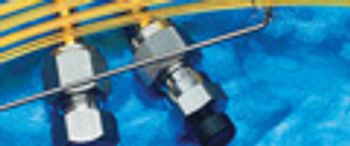
October 2006. This brief review introduces the GCxGC technique and its advantages, hich primarily lie in the area of ncreased separation power for volatile chemical analysis.
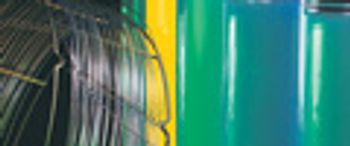
September 2006. In analytical chemistry, the continual quest for enhanced sensitivity and specificity - in gas chromatography (GC), this can be equated to separation power - remain the common goal in the development of new analytical methodologies. Today, GC is still the most widely used method for the analysis of volatile and semivolatile organic compounds. When coupled with the right choice of detector for the specific application, a wide linearity range and low limit of detection (LOD) can be met. For GC analyses, many approaches can be used to achieve greater sensitivity and lower LOD. They can be classified broadly into four categories: improved sampling (sample preparation) strategies; sample introduction methods; improved chromatographic performance; and alternative (selective–sensitive) detection transducers. This article provides an up-to-date review of existing and emerging chromatographic innovations, based upon these four strategies, that will improve sensitivity and detection limits of trace..














